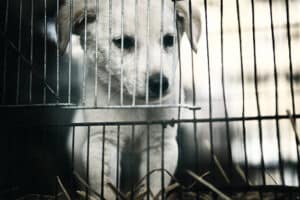A new intake should never commence with teaching a pup to walk at heel.

Certain loud sounds and quick movements will increase their excitement threshold and height the risk of conflict between puppies in the kindergarten class. It should be the aim and objective of any instructor to create a calm environment in which to train the owners and their dogs.
Static exercises such as “Sit!” or “Down!” will help achieve this rapidly. Also, getting every handler to sit on the ground in a large circle with the dogs on a leash but not being instructed to do anything specific will result quite quickly in most of the pet puppies to lie or sit calmly alongside their owners.
While calmness prevails the instructor can discuss the purposes and expectations from training and can elucidate certain basic principles of animal behaviour, the correct manner in which people should respond to anything the puppy may be doing. Owners can be taught that a dog’s name is merely a command for the animal, but a sentimental tag for the humans and should only be used at appropriate times such as prior to feeding but never when you want the dog out of the house.
Most instructors will elaborate on the concepts of anthropomorphism where human emotions are attributed to animals. Dogs can never be jealous, revengeful, can never know it has done wrong and can never suffer guilt. A well-informed dog trainer will explain how dogs think in the now and do not mope over their abusive puppyhood or contemplate the future. These concepts are vast.
Some instructors will discuss diet, manners of feeding, equipment suitable for use, appropriate toys and when to offer them and will delve into the importance of the pack structure within the home incorporating all animals and humans. In essence the trainers train the owners how to train their dogs. A properly structured inaugural lesson which refrains from movement exercises is the key to a successful course.
The object of training exercises is to teach the puppy to behave in a socially acceptable manner at all times not just when there is fear of retribution. Any form of direct punishment is not permitted. One must never train through fear.
It must be recognised that certain individual puppies do not respond to training within a group environment. A trainer should be vigilant about signs of stress among dogs in the class. Some might be anxious about certain activities where different methods may have to be applied. Just being in the puppy kindergarten environ can be stressful which may block any possibility of learning.
A good instructor will notice this, make the owners aware and may recommend private tuition or training in a different area. Unfortunately, some trainers refuse to acknowledge that their classes do not satisfy the needs of all dogs and all people and will persevere without regard, usually blaming the owner for the poor success.
Some dogs are not bright therefore not readily trainable. Forcing any dog into a stressful situation may create behaviour problems the pup never came in with in the first instance, or may end up with a mild disorder aggravated by the angst around incompatible methods for that particular character.
Puppies that refuse to enter a class after a few lessons or an owner who fails to attend the subsequent lesson needs to be followed up with immense sensitivity, consideration and professionalism.






